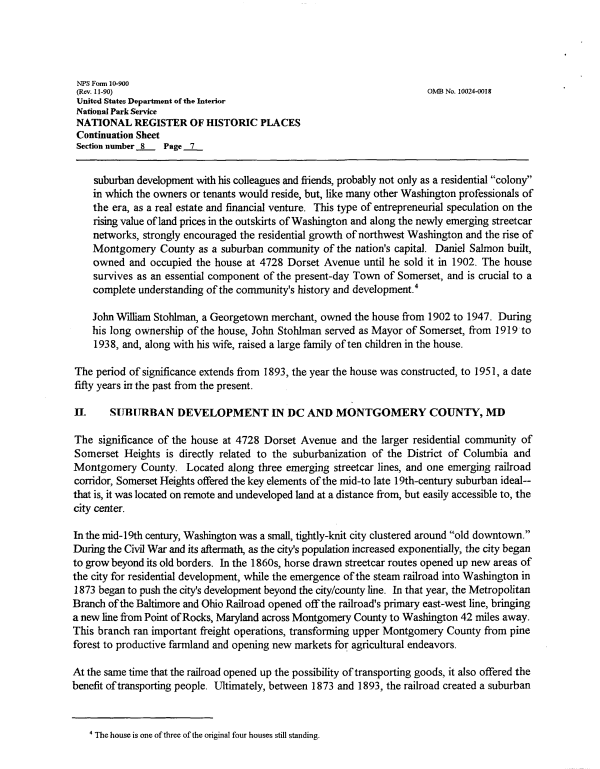 |
||||
|
DEPARTMENT OF HOUSING AND COMMUNITY DEVELOPMENT, MARYLAND HISTORICAL TRUST (Historic Sites Survey) var.d. MSA SE16-5 Image No: se16-5-0233 Enlarge and print image (72K) |
 |
||||
|
DEPARTMENT OF HOUSING AND COMMUNITY DEVELOPMENT, MARYLAND HISTORICAL TRUST (Historic Sites Survey) var.d. MSA SE16-5 Image No: se16-5-0233 Enlarge and print image (72K) |
| NFS Forai 10-900 (Rev. 11-90) OMB No. 10024-0018 United States Department of the Interior National Park Service NATIONAL REGISTER OF HISTORIC PLACES Continuation Sheet Section number 8 Page 7 suburban development with his colleagues and friends, probably not only as a residential "colony" in which the owners or tenants would reside, but, like many other Washington professionals of the era, as a real estate and financial venture. This type of entrepreneurial speculation on the rising value of land prices in the outskirts of Washington and along the newly emerging streetcar networks, strongly encouraged the residential growth of northwest Washington and the rise of Montgomery County as a suburban community of the nation's capital. Daniel Salmon built, owned and occupied the house at 4728 Dorset Avenue until he sold it in 1902. The house survives as an essential component of the present-day Town of Somerset, and is crucial to a complete understanding of the community's history and development.4 John William Stohlman, a Georgetown merchant, owned the house from 1902 to 1947. During his long ownership of the house, John Stohlman served as Mayor of Somerset, from 1919 to 1938, and, along with his wife, raised a large family often children in the house. The period of significance extends from 1893, the year the house was constructed, to 1951, a date fifty years in the past from the present. H. SUBURBAN DEVELOPMENT IN DC AND MONTGOMERY COUNTY, MD The significance of the house at 4728 Dorset Avenue and the larger residential community of Somerset Heights is directly related to the suburbanization of the District of Columbia and Montgomery County. Located along three emerging streetcar lines, and one emerging railroad corridor, Somerset Heights offered the key elements of the mid-to late 19th-century suburban ideal— that is, it was located on remote and undeveloped land at a distance from, but easily accessible to, the city center. In the mid-19th century, Washington was a small, tightly-knit city clustered around "old downtown." During the Civil War and its aftermath, as the city's population increased exponentially, the city began to grow beyond its old borders. In the 1860s, horse drawn streetcar routes opened up new areas of the city for residential development, while the emergence of the steam railroad into Washington in 1873 began to push the city's development beyond the city/county line. In that year, the Metropolitan Branch of the Baltimore and Ohio Railroad opened off the railroad's primary east-west line, bringing a new line from Point of Rocks, Maryland across Montgomery County to Washington 42 miles away. This branch ran important freight operations, transforming upper Montgomery County from pine forest to productive farmland and opening new markets for agricultural endeavors. At the same time that the railroad opened up the possibility of transporting goods, it also offered the benefit of transporting people. Ultimately, between 1873 and 1893, the railroad created a suburban 4 The house is one of three of the original four houses still standing. |